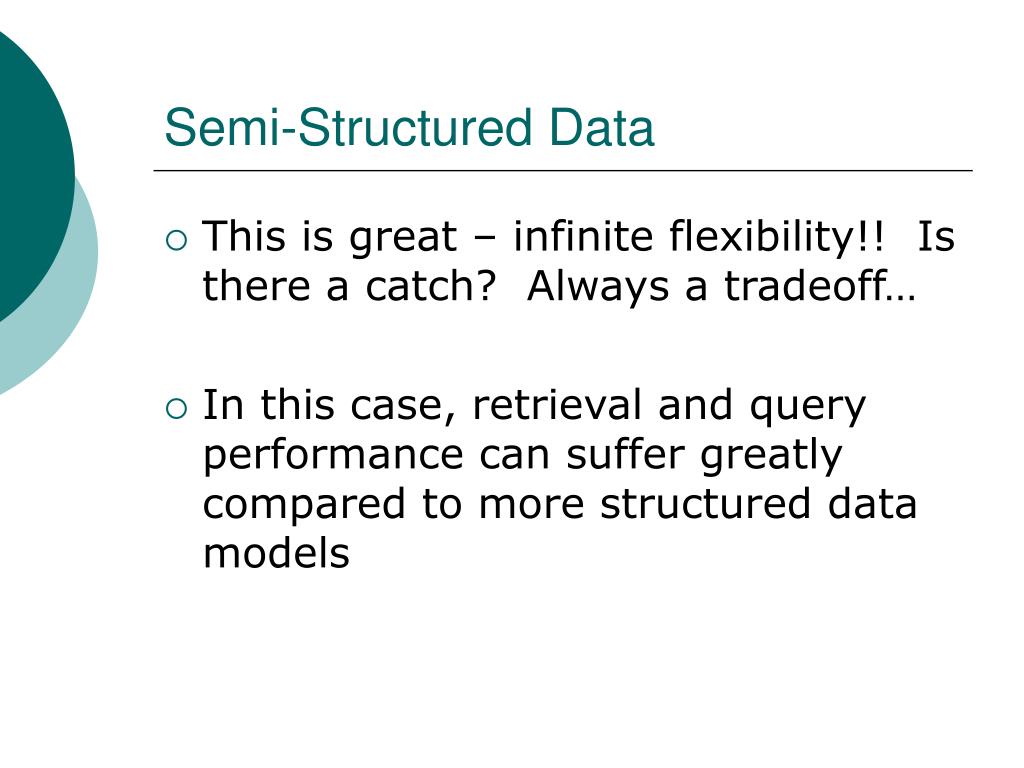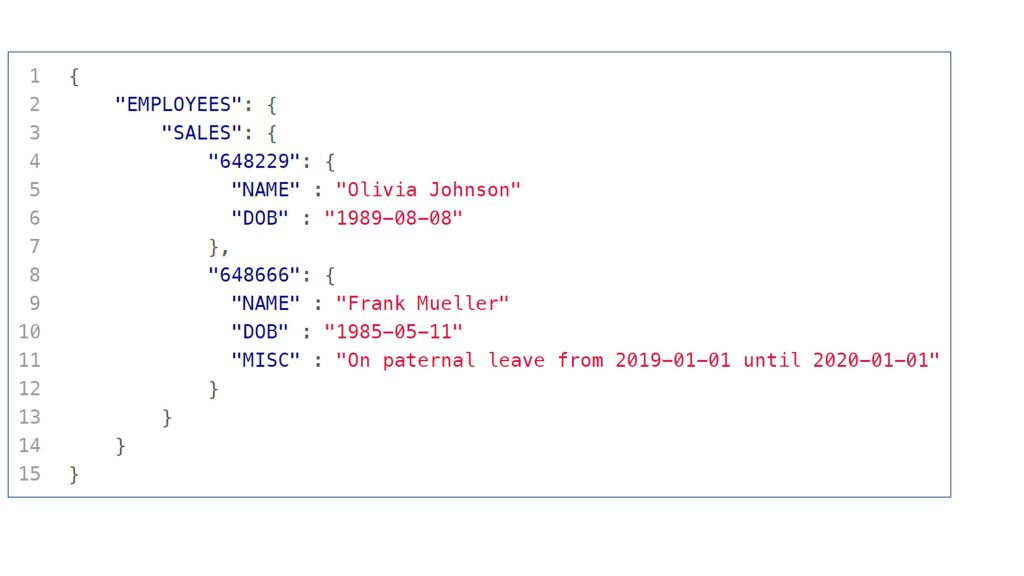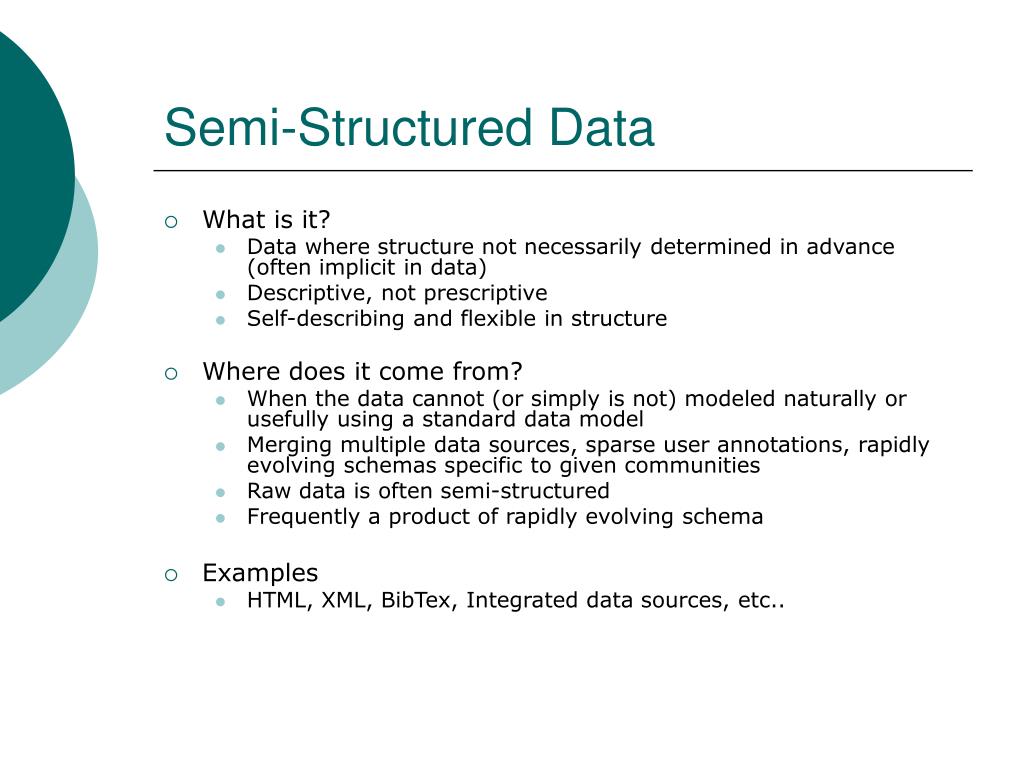What is Semi-Structured Data? A Quick Overview
Semi-structured data represents a versatile and flexible data type that combines elements of both structured and unstructured data. Unlike structured data, which adheres to a rigid schema with predefined fields, semi-structured data does not require a fixed schema. However, it still exhibits some organizational properties, making it more manageable than unstructured data. These characteristics make semi-structured data an essential component in modern data processing and management.
Examples of semi-structured data include XML documents, JSON files, email messages, and HTML documents. These data formats often contain tags, markups, or other metadata that provide structure and context, enabling efficient data processing and analysis. By understanding the nuances of semi-structured data, organizations can unlock valuable insights and make more informed decisions.
XML: A Popular Semi-Structured Data Format
XML (eXtensible Markup Language) is a widely-used semi-structured data format that provides a flexible and self-descriptive means of encoding data. XML documents consist of elements, attributes, and content, with elements defined by a set of tags wrapped around the data. This tag-based structure allows XML to be both human-readable and machine-readable, making it an ideal choice for data exchange and integration.
An example of XML data is as follows:
JSON: A Lightweight Alternative for Semi-Structured Data
JSON (JavaScript Object Notation) is a lightweight, popular data interchange format that provides a simple and efficient way to represent semi-structured data. JSON is often used for data exchange between web applications and servers, configuration files, and data storage. Its hierarchical structure and simplicity make it an attractive choice for examples of semi-structured data.
A JSON object consists of key-value pairs, where keys are strings and values can be strings, numbers, booleans, arrays, or other JSON objects. Here’s an example of JSON data representing a simple recipe:
json
{
“recipe”: {
“name”: “Spaghetti Bolognese”,
“ingredients”: [
“500g spaghetti”,
“2 tbsp olive oil”,
“1 onion, chopped”,
“2 cloves garlic, minced”,
“500g ground beef”,
“800g canned crushed tomatoes”,
“1 tsp dried basil”,
“1 tsp dried oregano”,
“Salt and pepper, to taste”
],
“instructions”: [
“Boil spaghetti according to package instructions.”,
“Heat olive oil in a large pan over medium heat.”,
“Add onion and garlic, sautéing until softened.”,
“Add ground beef, cook until browned.”,
“Stir in crushed tomatoes, basil, oregano, salt, and pepper.”,
“Simmer for 20 minutes, then serve over spaghetti.”
]
}
}
This example demonstrates the simplicity and readability of JSON, making it a popular choice for semi-structured data representation. JSON is often used in web development, IoT devices, and data storage, and it remains an essential format for examples of semi-structured data.
Email Messages: A Practical Example of Semi-Structured Data
Email messages can be considered a practical example of semi-structured data, as they contain both metadata and content with a discernible structure. The metadata, such as the sender, recipient, subject, date, and time, are organized in a specific format, while the content itself can be further categorized into headers, body, and attachments.
Email clients and servers handle semi-structured data by parsing and organizing the metadata and content for user convenience. For instance, email clients display the sender, subject, and date in the inbox view, allowing users to quickly identify and manage their messages. Similarly, servers use metadata to route and store emails in the appropriate mailboxes, ensuring efficient delivery and retrieval.
An example of an email message’s metadata and content structure is as follows:
yaml
—
Metadata:
– From: [[email protected]](mailto:[email protected])
– To: [[email protected]](mailto:[email protected])
– Subject: Meeting Agenda
– Date: Mon, 1 Feb 2023 10:30:00 -0500
Content-Type: text/plain; charset=”UTF-8″
—
Hello,
Here is the agenda for our meeting on Tuesday at 2 PM.
1. Project updates
2. Budget review
3. Team assignments
Best regards,
[Your Name]
This example demonstrates how email messages can be considered semi-structured data, with their metadata and content structure. Understanding this structure is essential for email clients, servers, and other applications that process email data, making it a valuable example of semi-structured data in real-world applications.
HTML Documents: Semi-Structured Data in Web Pages
HTML (HyperText Markup Language) documents are a common example of semi-structured data found in web pages. HTML uses a tag-based structure to define the content, layout, and metadata of a web page, making it a versatile format for organizing and presenting information on the internet.
An HTML document typically consists of various tags, such as headings (h1, h2, h3, etc.), paragraphs (p), lists (ul, ol), links (a), images (img), and more. These tags provide structure and context to the content, enabling search engines, web scrapers, and browsers to process and display the data in a meaningful way.
Here’s a simple example of an HTML document:
html
Welcome to My Website
This is a simple example of an HTML document.
- HTML
- is a
- markup language

Search engines and web scrapers process HTML data by parsing the tags and extracting the relevant information, such as titles, headings, and content. This allows them to index, categorize, and analyze web pages for various purposes, including search results, content aggregation, and data mining.
Understanding the semi-structured nature of HTML documents is crucial for web developers, designers, and data analysts, as it enables them to create, manage, and extract valuable information from web pages effectively.
NoSQL Databases: Managing Semi-Structured Data at Scale
NoSQL databases have emerged as a popular solution for managing large-scale semi-structured data, offering flexibility, scalability, and performance that traditional relational databases often struggle to match. Systems like MongoDB, Couchbase, and Cassandra are designed to handle various data models, including key-value, document, column-family, and graph databases.
Unlike relational databases, which enforce a rigid schema and require data to fit into predefined tables and columns, NoSQL databases are schema-agnostic. This means they can store and manage semi-structured data without requiring a fixed schema, allowing for greater flexibility and adaptability in handling real-world data.
NoSQL databases differ from traditional relational databases in several ways:
Data Model: NoSQL databases support various data models, enabling them to handle diverse data types and structures more effectively than relational databases.
Scalability: NoSQL databases are designed to scale horizontally, distributing data and workload across multiple nodes or servers, making them more suitable for handling large-scale semi-structured data.
Performance: NoSQL databases often prioritize performance and low latency, providing faster data access and manipulation than relational databases for certain workloads.
ACID Compliance: Many NoSQL databases relax ACID (Atomicity, Consistency, Isolation, Durability) transaction properties to achieve higher performance and scalability, although some systems offer configurable ACID compliance levels.
When working with semi-structured data in NoSQL databases, it’s essential to follow best practices, such as data validation, normalization, and security. Implementing robust data validation rules can help ensure data integrity and consistency, while normalization can minimize data redundancy and improve storage efficiency. Additionally, implementing appropriate security measures, such as encryption, access control, and auditing, is crucial for protecting sensitive data and maintaining regulatory compliance.
Using Semi-Structured Data in Data Analysis and Machine Learning
Semi-structured data, such as XML and JSON, can be a valuable resource in data analysis and machine learning. These data formats, which combine elements of structured and unstructured data, offer flexibility and versatility that make them suitable for various applications. By utilizing tools and libraries designed for processing semi-structured data, data analysts and machine learning engineers can unlock valuable insights and build more accurate models.
Data analysis tools like Pandas, a popular Python library, can parse and manipulate semi-structured data with ease. For instance, Pandas can read JSON files directly into a DataFrame, a powerful in-memory data structure that supports various data manipulation and analysis operations. Similarly, libraries like lxml and Beautiful Soup can parse and extract data from XML and HTML documents, enabling data analysts to work with semi-structured data from web sources.
Machine learning libraries and frameworks, such as TensorFlow, PyTorch, and Scikit-learn, often provide built-in support for processing semi-structured data. These libraries typically offer functions and classes for parsing and converting semi-structured data into numerical representations that can be used in machine learning algorithms. For example, TensorFlow’s feature columns allow users to convert categorical features, such as strings or integers, into numerical representations, enabling machine learning models to process semi-structured data more effectively.
Real-world applications of semi-structured data in data analysis and machine learning include:
Sentiment Analysis: Analyzing customer reviews, social media posts, and other textual data in JSON or XML format to determine public sentiment towards products, services, or events.
Recommender Systems: Processing user data, such as browsing and purchase history stored in NoSQL databases, to build personalized recommendations for individual users.
Natural Language Processing (NLP): Extracting and processing metadata, such as part-of-speech tags, named entities, and syntactic structures, from text data in HTML or XML format to improve NLP models’ performance.
Time-Series Analysis: Analyzing time-stamped data, such as financial transactions or sensor readings, stored in semi-structured formats like JSON or XML, to identify trends, patterns, and anomalies.
When working with semi-structured data in data analysis and machine learning, it’s essential to follow best practices, such as data validation, normalization, and security. Implementing robust data validation rules can help ensure data integrity and consistency, while normalization can minimize data redundancy and improve storage efficiency. Additionally, implementing appropriate security measures, such as encryption, access control, and auditing, is crucial for protecting sensitive data and maintaining regulatory compliance.
Best Practices for Working with Semi-Structured Data
Semi-structured data, such as XML and JSON, offer numerous benefits in terms of flexibility and versatility. However, working with these data formats also presents unique challenges that require specific best practices to ensure data integrity, consistency, and security. Here are some best practices for working with semi-structured data:
Data Validation
Implementing robust data validation rules is crucial for maintaining data integrity and consistency in semi-structured data. Data validation can help identify and correct errors, inconsistencies, and missing values, ensuring that the data is accurate and reliable. Various tools and libraries, such as XML Schema, RelaxNG, and JSON Schema, can be used to define validation rules for semi-structured data formats.
Normalization
Normalization is the process of organizing data to minimize redundancy and improve storage efficiency. In the context of semi-structured data, normalization involves organizing the data into a hierarchical structure that minimizes data redundancy and improves data consistency. Normalization can help reduce data storage costs, improve data processing performance, and minimize the risk of data inconsistencies and anomalies.
Data Security
Implementing appropriate security measures is essential for protecting sensitive data and maintaining regulatory compliance. Encryption, access control, and auditing are critical security measures that can help ensure the confidentiality, integrity, and availability of semi-structured data. When working with semi-structured data, it’s essential to follow best practices for data security, such as encrypting sensitive data, implementing access control policies, and maintaining audit logs.
Optimizing Data Processing and Storage
Optimizing data processing and storage is crucial for improving the performance and scalability of semi-structured data systems. Techniques such as data compression, indexing, and caching can help improve data processing performance and reduce data storage costs. When working with semi-structured data, it’s essential to follow best practices for data processing and storage optimization, such as compressing large data sets, indexing frequently accessed data, and caching frequently used data.
Working with Tools and Libraries
Various tools and libraries are available for processing semi-structured data, such as XML parsers, JSON parsers, and NoSQL databases. When working with semi-structured data, it’s essential to choose the right tools and libraries for the job, taking into account factors such as performance, scalability, and ease of use. Additionally, it’s essential to stay up-to-date with the latest developments in semi-structured data processing tools and libraries, as new technologies and approaches emerge regularly.
Understanding Data Formats and Structures
Understanding the data formats and structures used in semi-structured data is crucial for working with these data types effectively. Familiarizing yourself with the syntax and semantics of XML, JSON, and other semi-structured data formats can help you process and analyze these data types more efficiently and accurately. Additionally, understanding the hierarchical structure and metadata of semi-structured data can help you extract insights and value from these data types.
Emphasizing Data Quality
Data quality is a critical factor in semi-structured data processing and analysis. Ensuring that the data is accurate, complete, and consistent is essential for building reliable and accurate models and insights. Implementing data quality checks, such as data profiling, data cleansing, and data enrichment, can help improve data quality and ensure that the data is fit for purpose.
Training and Education
Training and education are essential for working with semi-structured data effectively. Familiarizing yourself with the concepts, tools, and best practices associated with semi-structured data processing and analysis can help you work with these data types more efficiently and accurately. Additionally, staying up-to-date with the latest developments in semi-structured data processing and analysis can help you stay competitive and innovative in your field.





